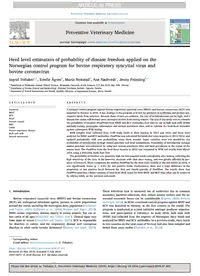
2018 Herd level estimation of probability of disease freedom applied on the Norwegian control program for bovine respira PDF
Preview 2018 Herd level estimation of probability of disease freedom applied on the Norwegian control program for bovine respira
Contents lists available at ScienceDirect Preventive Veterinary Medicine journal homepage: www.elsevier.com/locate/prevetmed Herd level estimation of probability of disease freedom applied on the Norwegian control program for bovine respiratory syncytial virus and bovine coronavirus Ingrid Toftakera,⁎, Estelle Ågrenb, Maria Stokstada, Ane Nødtvedta, Jenny Frösslingb,c a Department of Production Animal Clinical Sciences, Norwegian University of Life Sciences, P.O. Box 8146 Dep, Oslo, Norway b Department of Disease Control and Epidemiology, National Veterinary Institute, Uppsala, Sweden c Department of Animal Environment and Health, Swedish University of Agricultural Sciences, Skara, Sweden A R T I C L E I N F O Keywords: BRSV BCV BCoV Disease control BRD Cattle Bovine respiratory disease Bulk tank milk Animal movements A B S T R A C T A national control program against bovine respiratory syncytial virus (BRSV) and bovine coronavirus (BCV) was launched in Norway in 2016. A key strategy in the program is to test for presence of antibodies and protect test- negative herds from infection. Because these viruses are endemic, the rate of re-introduction can be high, and a disease-free status will become more uncertain as time from testing elapses. The aim of this study was to estimate the probability of freedom (PostPFree) from BRSV and BCV antibodies over time by use of bulk tank milk (BTM) antibody-testing, geographic information and animal movement data, and to validate the herd-level estimates against subsequent BTM testing. BTM samples were collected from 1148 study herds in West Norway in 2013 and 2016, and these were analyzed for BRSV and BCV antibodies. PostPFree was calculated for herds that were negative in 2013/2014, and updated periodically with new probabilities every three months. Input variables were test sensitivity, the probability of introduction through animal purchase and local transmission. Probability of introduction through animal purchase was calculated by using real animal movement data and herd prevalence in the region of the source herd. The PostPFree from the final three months in 2015 was compared to BTM test results from March 2016 using a Wilcoxon Rank Sum Test. The probability of freedom was generally high for test-negative herds immediately after testing, reflecting the high sensitivity of the tests. It did however, decrease with time since testing, and was greatly affected by pur- chase of livestock. When comparing the median PostPFree for the final three months to the test results in 2016, it was significantly lower (p < 0.01) for test positive herds. Furthermore, there was a large difference in the proportion of test positive herds between the first and fourth quartile of PostPFree. The results show that PostPFree provides a better estimate of herd-level BTM status for both BRSV and BCV than what can be achieved by relying solely on the previous test-result. 1. Introduction Bovine respiratory syncytial virus (BRSV) and bovine coronavirus (BCV) are widespread infectious agents, present in cattle populations around the world, including the Norwegian dairy population (Valarcher and Taylor, 2007; Gulliksen et al., 2009; Boileau and Kapil, 2010). BRSV causes respiratory disease, mostly in young animals, but can af- fect cattle of all ages (Valarcher and Taylor, 2007). Clinical signs vary from none to severe (Valarcher and Taylor, 2007). BCV is responsible for diarrhea in calves, and for respiratory disease and contagious diarrhea in adult cattle (winter dysentery) (Boileau and Kapil, 2010). These infections lead to increased use of antibiotics due to common secondary bacterial infections, they reduce animal welfare and the as- sociated economic losses can be considerable (Larsen, 2000; Boileau and Kapil, 2010). In 2016, a national control program against BRSV and BCV was launched in Norway, as the first country in the world. The program is conducted as a joint initiative amongst producer organiza- tions, and participation is voluntary. In early 2016, bulk tank milk (BTM) was collected from the majority of Norwegian dairy herds and analyzed for BRSV and BCV antibodies. In a previous study, dairy herds in two counties on the west coast of Norway had also been sampled and tested three years earlier (Toftaker et al., 2016). https://doi.org/10.1016/j.prevetmed.2018.07.002 Received 20 May 2018; Accepted 3 July 2018 ⁎ Corresponding author. E-mail address:
